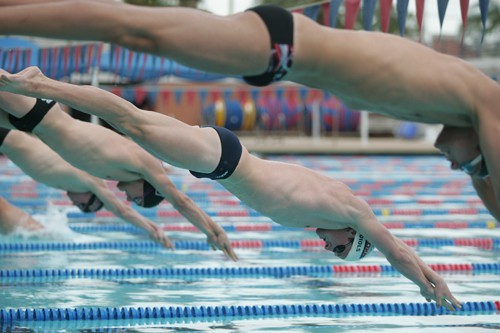For years, the UA swim and dive team has used the Texas Invitational in Austin, Texas, happening today, tomorrow and Saturday, as a springboard to make qualifying times for the NCAA Championships in March.
But due to the NCAA’s banning of the high-tech, full-body swimsuit in late July, the number of UA swimmers that will reach the new time standards necessary to qualify for a top spot in the NCAAs will be few and far between.
“”Because they didn’t change the ‘A’ standards since they had these technical suits from last year, the ‘A’ standards are extremely fast,”” head coach Frank Busch said. “”There’s a history as to, ‘this time makes it and this time generally doesn’t.’ But now as the suits are off, so to speak, it will be a little bit of a question mark as to what times will be fast enough to make it.””
Unlike most programs, Arizona spends weeks resting up for this one meet in hopes of qualifying as many swimmers for the NCAAs as possible.
If the swimmers can qualify for the NCAAs, they will be able to rest up before March rather than exerting energy trying to qualify at the Pacific 10 Conference meet.
And in a sport where success and failure ares separated by milliseconds, that extra rest is invaluable.
“”We think it’s a great advantage (to qualify early) because our (swimmers) will be unshaven when they go to the national championships as opposed to being shaved two and a half weeks prior to a conference meet,”” said Busch.
But because of those extremely fast time-splits that came as a result of the now-banned full-body suits, the number of A standards that are met should dramatically decrease.
“”In some cases, the most that will make (“”A”” standards) will be ten,”” Busch said. “”And I’m not talking about ten of our kids, but ten across the country.””
Last year was the first year that the new-technology full-body suits were allowed in the collegiate ranks. The state-of-the-art suits boosted race times for virtually everyone who chose to wear it and the qualifying times were adjusted to fit the suits.
In fact, a ridiculous 70 NCAA meet records were set in 2009 as of July 29, clearly a byproduct of the high-tech suits.
“”The suits were making people so fast that it kind of got out of control,”” said senior swimmer Jordan Smith. “”They were doing a lot of different things like holding your core and making you float better.””
As of now, men’s suits cannot exceed the knee-to-waist region, and women’s suits the knee-to-shoulder area. But as the suits changed, the NCAA qualifying standards didn’t, putting a team that places so much emphasis on this meet at a clear disadvantage.
Busch admitted that the team will be behind the eight ball a little bit in regards to meeting “”A”” standards, but believes they will still reach a handful of “”B”” standards.
Although the banning of the suits certainly levels the playing field and was a great long-term move, it puts the Wildcats, and every other team, at a disadvantage at the Texas Invite.
Although it will be difficult for the UA Swim and Dive team to reach those ridiculously fast “”A”” standards, it will be so for every other team as well. Arizona expects to finish atop the competition.
“”I think Arizona swimming will really be setting the bar,”” Smith said. “”A lot of teams don’t rest this early, they usually rest for the conference meet, so we’re usually the one team’s are gunning for.””









